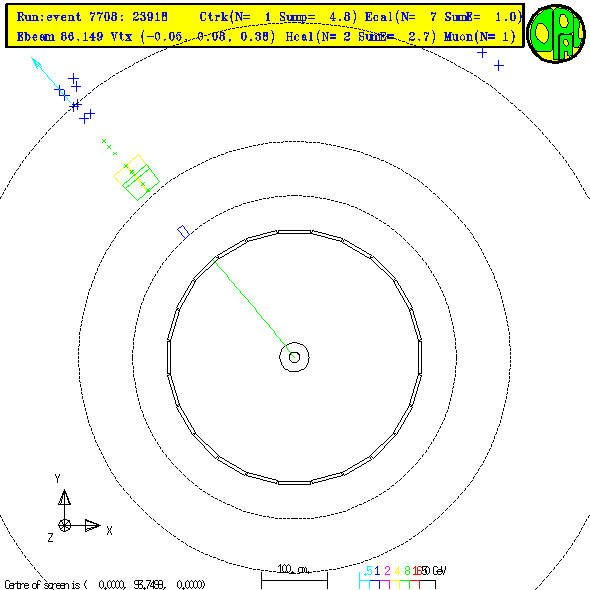The Detector
AT LEP there were four main experiments : ALEPH,
The OPAL experiment is approximately cylindrical in shape. The particles are produced on the axis of the cylinder at the centre and then travel outwards. As they do so, the particles pass through several different types of detectors, which are arranged in concentric cylinders about the axis. Different types of particle leave different signals in the various detectors and this allows us to distinguish them. Here is a sketch of the experiment.
Let's have a look at an example picture of a particle interaction. This shows the cylindrical detector viewed from one end. Therefore the concentric cylinders corresponding to the different dectectors show up as concentric circles. (Here is a picture of a similar detector ALEPH when fully assembled and viewed end-on. Here is a picture of OPAL as the cylinders are being assembled).
End-On View of Detector

Travelling from the inside outwards, the first detector is the “inner tracking chamber” that sees the tracks produced by electrically charged particles. (A charged particle track is shown as the green line in the picture.) You may just be able to see that the track is very slightly curved. This is because a magnetic field is applied. (In the picture the direction of the magnetic field is perpendicular to the screen.) By measuring very accurately the degree of curvature we can determine the momentum of each charged particle track.
Next on its outward journey the particle passes through a detector called the "electromagnetic calorimeter". As it interacts with the atoms in the detector the particle loses energy. The detector measures the total amount of energy the particle deposits; that is why it is called a calorimeter. (In the picture the energy deposited is shown as the blue rectangle.)
In the picture a colour code is used to indicate the momentum of charged particle tracks and the energy deposited in the calorimeters. A scale at the bottom of the picture shows which colour corresponds to which range of energy/momentum. Thus, lt blue corresponds to energy/momentum of between 0 and 0.5 GeV, blue to between 0.5 and 1.0 GeV, purple to between 1.0 and 2.0 GeV, and so on. Tracks and clusters drawn in black correspond to energy/momentum of greater than 16 GeV. (You should be able to see that the charged track in the picture corresponds to a momentum of between 4 and 8 GeV and that the cluster in the electromagnetic calorimeter corresponds to an energy of between 0.5 and 1.0 GeV.)
Many particles lose all their energy in the electromagnetic calorimeter and therefore progress no further. However, the particle in the picture passes through the electromagnetic calorimeter and into the next detector, which is called the "hadronic calorimeter". The energy the particle deposits in the hadronic calorimeter is shown in the picture as the green rectangle and crosses.
Almost all particles lose all of their remaining energy in the hadronic calorimeter and therefore progress no further. However, the particle in the picture passes through the hadronic calorimeter and into the outermost detectors, which are called the "muon chambers". The signals the particle produces in the muon chambers are shown as the blue crosses and the lt blue arrow. A muon is the only type of particle that is likely to pass through all the calorimeters and leave signals in the muon chambers.
Look back at the end view picture of a real experiment to see if you can identify the 4 different types of concentric detector.
Sometimes it's useful to look at the detector and the particle signals from the side. Here is a picture of the same "event" we have been looking at already, but from side-on.
Side View of Detector

By looking at the different signals they produce in the various detectors we will try to distinguish between three different types of particles: muons, electrons and hadrons. Click on the items below to see how these particles differ from one another.
some more example events containing a muon
example events containing an electron
example events containing a hadron
Once you've understood the way we identify the tracks produced by the
different types of particles, then please:
![]() click
here to proceed to the next part of the programme, which is "Part
1".
click
here to proceed to the next part of the programme, which is "Part
1".